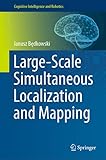Large-Scale Simultaneous Localization and Mapping [electronic resource] /
Material type: TextSeries: Cognitive Intelligence and RoboticsPublisher: Singapore : Springer Nature Singapore : Imprint: Springer, 2022Edition: 1st ed. 2022Description: XVIII, 308 p. 204 illus., 174 illus. in color. online resourceContent type:
TextSeries: Cognitive Intelligence and RoboticsPublisher: Singapore : Springer Nature Singapore : Imprint: Springer, 2022Edition: 1st ed. 2022Description: XVIII, 308 p. 204 illus., 174 illus. in color. online resourceContent type: - text
- computer
- online resource
- 9789811919725
- 629.892 23
- TJ210.2-211.495
Chapter 1. Introduction -- Chapter 2. Terminology -- Chapter 3. Weighted Non Linear Least Square Optimization -- Chapter 4. Coordinate Systems -- Chapter 5. Mobile mapping data -- Chapter 6. Mobile Mapping Systems -- Chapter 7. Ground truth data sources -- Chapter 8. Trajectory estimation -- Chapter 9. Nearest observations search -- Chapter 10. Camera metrics -- Chapter 11. LiDAR metrics -- Chapter 12. Constraints -- Chapter 13. Metrics’ fusion -- Chapter 14. Building large scale SLAM optimization -- Chapter 15. Loop closing and change detection -- Chapter 16. Final map qualitative and quantitative evaluation.
This book is dedicated for engineers and researchers who would like to increase the knowledge in area of mobile mapping systems. Therefore, the flow of the derived information is divided into subproblems corresponding to certain mobile mapping data and related observations’ equations. The proposed methodology is not fulfilling all SLAM aspects evident in the literature, but it is based on the experience within the context of the pragmatic and realistic applications. Thus, it can be supportive information for those who are familiar with SLAM and would like to have broader overview in the subject. The novelty is a complete and interdisciplinary methodology for large-scale mobile mapping applications. The contribution is a set of programming examples available as supportive complementary material for this book. All observation equations are implemented, and for each, the programming example is provided. The programming examples are simple C++ implementationsthat can be elaborated by students or engineers; therefore, the experience in coding is not mandatory. Moreover, since the implementation does not require many additional external programming libraries, it can be easily integrated with any mobile mapping framework. Finally, the purpose of this book is to collect all necessary observation equations and solvers to build computational system capable providing large-scale maps.


There are no comments on this title.